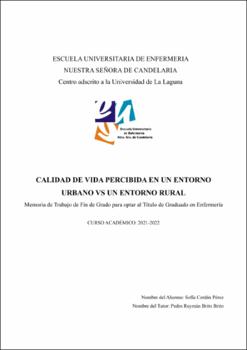Calidad de vida percibida en un entorno urbano vs un entorno rural.
Author
Cerdán Pérez, SofíaDate
2022Abstract
Sufrimos una crisis medio ambiental. Tal es así que se estima que un 24% de la carga mundial
de la morbilidad y un 23% de la mortalidad de los seres humanos se atribuye a factores
medioambientales. Sin embargo, no todas estas muertes se distribuyen de igual manera alrededor del
planeta. Las circunstancias y condiciones de cada zona en las que viven las personas ejerce una gran
influencia en la manera en la que el entorno afecta a la población. Así, se calcula que en las regiones
desarrolladas el porcentaje anterior de mortalidad se reduce a un 17%. Lo que equivaldría para Europa
a un total aproximado de 1,4 millones de muertes al año.
La Organización Mundial de la Salud ha clasificado en nueve a los factores principales a través
de los que el medio ambiente afecta a la salud humana. Entre ellos, los entornos urbanizados
constituyen una de esas áreas importantes del ambiente a tratar.
Al ser el entorno uno de los cuatro elementos que constituyen el metaparadigma enfermero y
Tenerife poseer núcleos poblacionales tan densos y edificados que han desplazado en gran medida a
los elementos naturales de los mismos, el objetivo de este proyecto de investigación se centra en
describir la calidad de vida percibida de los habitantes de dos entornos urbanos de Santa Cruz de
Tenerife, el barrio las Delicias y el barrio La Salud, frente a la calidad de vida percibida de los
habitantes de dos entornos rurales del mismo municipio, el pueblo de Taganana y el pueblo de Roque
Negro; para comprobar si efectivamente existen factores positivos o negativos a nivel de calidad de
vida físico-psíquico-social-ambiental en las personas en función del entorno en el que viven.
Para ello, se realiza un estudio de carácter observacional, descriptivo y transversal. La población
diana se conforma de aquellos individuos inscritos en los centros de salud de Ofra-Delicias y Barrio
de la Salud y, los centros periféricos de Roque Negro y Taganana. Y, mediante un muestreo no
probabilístico por conveniencia de 594 sujetos, se selecciona a los participantes del proyecto que
deben además cumplir con todos los criterios de inclusión y ninguno de los de exclusión propuestos.
Con el fin de obtener una valoración holística y para promover un comportamiento proambiental de los usuarios, las enfermeras colaboradoras que se reclutarán de los centros para la investigación
utilizarán como instrumento de recogida de datos el WHOQOL-100 y la Encuesta Nacional
Ambiental de In-Data, aunque con ciertas modificaciones en su elaboración final.
Los resultados del estudio se prevén favorables para aquellos habitantes en los que los elementos
naturales están más presentes en sus vidas, es decir, los participantes de Taganana y Roque Negro se
espera que presenten una mejor salud física, salud mental, relaciones sociales, calidad del ambiente
y comportamiento proambiental que los individuos que residen en los barrios de las Delicias y Barrio
la Salud.
Por último, se pretende con el estudio mejorar el bienestar común de la comunidad a la vez que
fomentar la participación enfermera en el cuidado medioambiental. We are experiencing an environmental crisis. So much so that it is estimated that 24% of the
global burden of disease and 23% of human mortality is attributed to environmental factors. However,
not all of these deaths are distributed equally around the planet. The circumstances and conditions of
each area in which people live exert a great influence on the way in which the environment affects
the population. Thus, it is estimated that in developed regions the previous percentage of mortality is
reduced to 17%. This would be equivalent to a total of approximately 1.4 million deaths per year for
Europe.
The World Health Organization has classified the main factors through which the environment
affects human health into nine. Among them, urbanized environments constitute one of those
important areas of the environment to be treated.
As the environment is one of the four elements that constitute the nursing metaparadigm and
Tenerife has such dense and built-up population centers that they have largely displaced their natural
elements, the objective of this research project is focused on describing the quality perceived quality
of life of the inhabitants of two urban areas of Santa Cruz de Tenerife, the Las Delicias neighborhood
and the La Salud neighborhood, compared to the perceived quality of life of the inhabitants of two
rural areas of the same municipality, the town of Taganana and the town of Roque Negro; to check if
there are indeed positive or negative factors at the level of physical-psychological-socialenvironmental quality of life in people depending on the environment in which they live.
For this, an observational, descriptive and cross-sectional study is carried out. The target
population is made up of those individuals enrolled in the health centers of Ofra-Delicias and Barrio
de la Salud and the peripheral centers of Roque Negro and Taganana. And, through a non-probabilistic
convenience sampling of 594 subjects, the project participants are selected who must also meet all
the inclusion criteria and none of the proposed exclusion criteria.
In order to obtain a holistic assessment and to promote a pro-environmental behavior of the users,
the collaborating nurses that will be recruited from the research centers will use the WHOQOL-100
and the In-Data National Environmental Survey as data collection instruments, although with certain
modifications in its final elaboration.
The results of the studies are expected to be favorable for those inhabitants in whom natural
elements are more present in their lives, that is, the participants from Taganana and Roque Negro are
expected to have better physical health, mental health, social relations, quality of environment and pro-environmental behavior than individuals residing in the neighborhoods of Las Delicias and Barrio
la Salud.
Finally, the aim of the study is to improve the common well-being of the community while
promoting nursing participation in environmental care.





